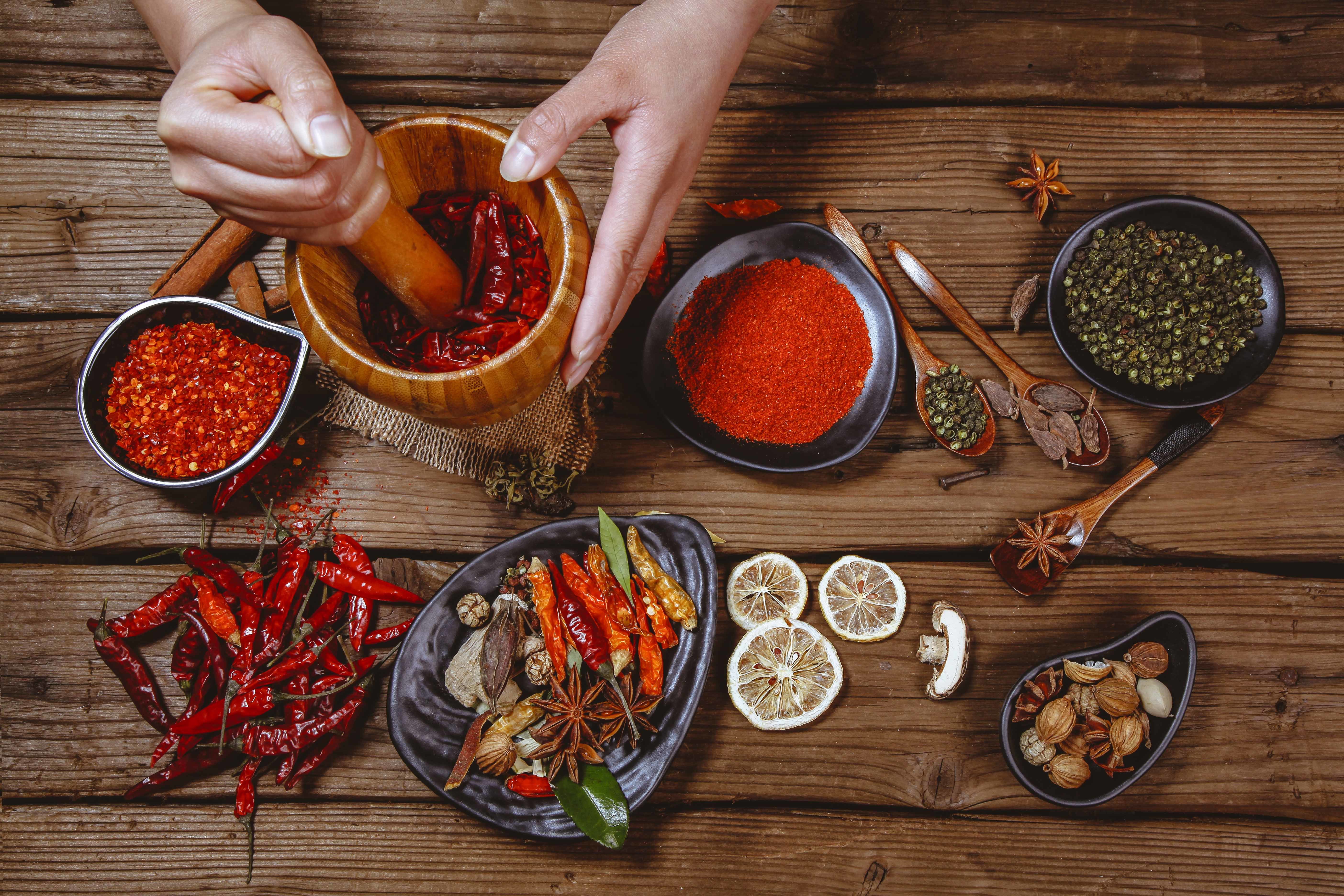Spicy Encyclopedia|How do chili peppers, onions, and garlic get their "spiciness"?
Published:
2023-12-25
As the Chinese saying goes: scallion is spicy to the eyes, garlic is spicy to the heart, chili pepper is spicy to the buttock and heart, Chinese leeks are spicy to the neck, and ginger is spicy to the head.
Many people are super crazy about spicy food. Speaking of it, I bet the chili pepper would be the No 1 that comes into our minds. Among different spicy foods, the chili pepper is only one of them, and different foods bring different spicy flavors.

Chili pepper -stimulating capsaicin
Chili peppers are annual or perennial herbs of the genus Capsicum, family Solanaceae. The "spiciness" of it is mainly from capsaicin, which is a natural biologically active ingredient synthesized by the superficial cells of the placenta of chili peppers. The spiciest part of the chili pepper is the spongy placenta and the white tendon that extends out from there, removing the placenta and the white tendon can greatly reduce the spicy flavor.
Capsaicin is an irritating substance that causes a burning sensation in areas such as the tongue and digestive tract and that’s why people will feel spicy when eating chili peppers. There are many benefits to consuming moderate amounts of capsaicin. Studies have shown that capsaicin can boost immunity, reduce inflammatory responses, and activate heat metabolism. However, excessive consumption of chili peppers will cause several discomforts such as diarrhea, stomach pain, and other symptoms.
Radish, horseradish - isothiocyanate
The spiciness of radish and chili pepper is different. The radish contains a compound substance of several unstable glucosinolates whose biological activity is limited and without any pungent odor, only in the enzyme degradation, do the resulting isothiocyanate degradation products have a pungent flavor.
Glucosinolates are not evenly distributed in radishes, usually, the skin contains more than the flesh, and the lower the upper content, the more the end content, so we will feel more spicy when we eat the skin.
Toothpaste-like green mustard (horseradish sauce) is the seasoning of many special-flavored small dishes, the taste is spicy and pungent. A lot of people can not resist this choking thrill, horseradish is its main ingredient. Horseradish is a kale plant native to West Asia, and isothiocyanate is the main bioactive ingredient in horseradish, mustard, and other cruciferous plants, with a pungent and stimulating flavor.
The intact cruciferous plants are not spicy, when subjected to grinding and chewing, the plant tissue cells destruct. The thioglucoside and endogenous sinigrin contact leads to an enzymatic reaction, resulting in the production of isothiocyanate. Just because of the high content of this ingredient in horseradish, mustard, and wasabi, the super pungent spicy aroma shows in the process of grinding.
The horseradish sauce was originally yellow, and food coloring was added to make it lime green.
Garlic - the changing allicin
As condiments, garlic is also very spicy, and that spiciness comes from the allicin.
The intact garlic is odorless, when the garlic tissue cells are broken, the endogenous garlic enzyme in the vesicles and the producer of allicin in the cytoplasm (alliin) in contact with each other, and enzyme reaction occurs into allicin, which is the source of the pungent flavor when you eat raw garlic cloves.
Unstable allicin can be decomposed into more stable diallyl sulfide, disulfide, trisulfide, tetrasulfide, and other small molecule sulfur-containing compounds, and allicin (defined as diallyl trisulfide in the national drug standard [Standard No.: WS-10001-HD-(0050)-2002]) is the major constituent in the decomposition products.
However, allicin is less heat resistant, and its activity decreases when it is heated, so sautéed garlic is not spicy.
Scallions - rich in sulfides
As the Chinese saying goes: scallion is spicy to the eyes, garlic is spicy to the heart, chili pepper is spicy to the buttock and heart, Chinese leeks are spicy to the neck, and ginger is spicy to the head. Among them, scallions, onions, and Chinese leeks all belong to the genus Allium in the lily family and are also important ingredients and seasonings in the kitchen. Their spicy flavor comes from the unique sulfide, but the essence is slightly different.
The scallion's spiciness comes from its characteristic sulfides, the most abundant of which are sulfur-containing compounds represented by S-propylmethane thiosulfate, dipropyl trisulfide, and dimercaptomethane.
The cooked scallion is not spicy, but if you directly gnaw on the raw scallion, especially the bottom white part, it will be spicy. This is because cooking oil can react chemically with the scallion matrix at high temperatures to produce a large amount of flavorful substances that effectively mitigate the spiciness.
Unlike common vegetables, the onion we usually eat is its bulb instead of leaves. The spiciness comes from the volatile substance in the bulb - dipropyl disulfide and other disulfide and trisulfide compounds. Cutting or chewing causes spillage, and contact with the eyes stimulates the free nerve endings in the cornea and stimulates the lacrimal glands to secrete tears.
Like scallions, the spiciness of onions will be reduced and mildly sweet flavor shows when subjected to heating.
The flavor of Chinese leeks is unique, especially when used to make delicious Fried Chinese Leek Dumplings. Chinese leeks are rich in volatile substances and contain a wide variety and high content of sulfur compounds, which are the main source of the aromatic flavor of fresh leeks.
Due to the dimethyl trisulfide, dimethyl disulfide, methyl prop-1-enyl disulfide, methyl allyl trisulfide and other sulfur ether compounds that make Chinese leeks have onion and garlic pungent aroma, also taste a bit spicy.
Raw Chinese leeks are more spicy while sautéed leeks are less and the aldehydes in them show a strong fried and grassy aroma.
Ginger - the fierce gingerol
Ginger is also a member of the spicy family. The spiciness comes mainly from gingerol, which is a general term for 6-gingerol, shogaol, vanillylacetone, and other spicy substances associated with ginger.
The dried ginger is even spicier because gingerol can be dehydrated and converted to shogaol, which is about twice as spicy as gingerol under dry conditions.
Similarly, the spiciness of ginger will be reduced when cooking, because shogaol will be converted to vanillylacetone by heat, vanillylacetone is low in spiciness and has a sweet flavor. So, putting a few slices of ginger when stewing soup is not only good for the taste of soup, but even the ginger slices inside are not very spicy.
Black pepper - piperine
Black Pepper Beef and Black Pepper Chicken Leg Rice are all delicious dishes, and the black pepper is the "flavorful magic secret". Although black pepper smells good, you will feel spicy when you eat raw.
The main spicy compound of black pepper is piperine, which is stored in the outer layer of black pepper rind and seed surface, the spiciness is about 1% of capsaicin, there are also studies mentioning that the caryophyllene in black pepper has a pungent spicy odor, as well as the 3-carene.
Black pepper is ground to make crushed black pepper and black pepper powder, which allows the full release of aromatic substances and adds more flavor to the ingredients. However, it must be sealed well or the aroma will be lost and the pungent flavor will disappear.
Different "spiciness" represents the authentic flavor of the world.
Which is your favorite?
Relative news







 sales@garlicare.com
sales@garlicare.com

 Feedback
Feedback 